Leadership and Teamwork: Problem Solutions and Managerial Approaches
VerifiedAdded on 2023/01/18
|6
|1666
|68
Report
AI Summary
This report explores the critical aspects of teamwork and leadership within organizational settings. It begins by defining teamwork and emphasizing its importance for achieving common goals and fostering collaboration. The main body of the report delves into two common teamwork problems: improper coordination and ineffective leadership. For the first problem, the report suggests the implementation of Tuckman's theory of team building, outlining the stages of forming, storming, norming, performing, and adjourning, and how a manager can use it to improve team dynamics. The second problem is addressed by applying situational leadership, which helps managers understand employees' interests and delegate appropriate roles, thereby enhancing motivation and performance. The conclusion highlights the benefits of teamwork, such as improved accountability, positive relationships among team members, and reduced employee turnover. References to relevant books and journals are provided to support the analysis.
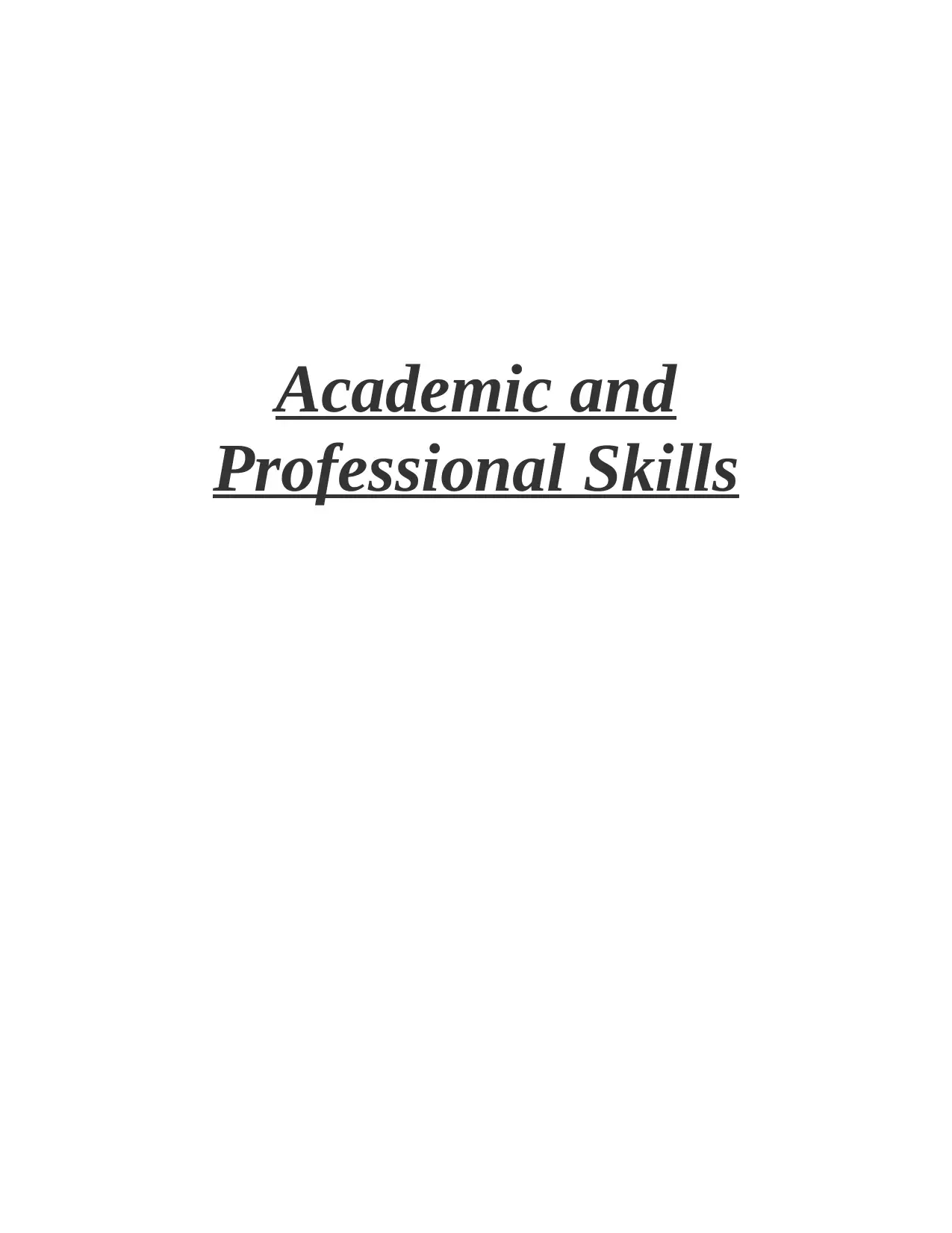
Academic and
Professional Skills
Professional Skills
Paraphrase This Document
Need a fresh take? Get an instant paraphrase of this document with our AI Paraphraser
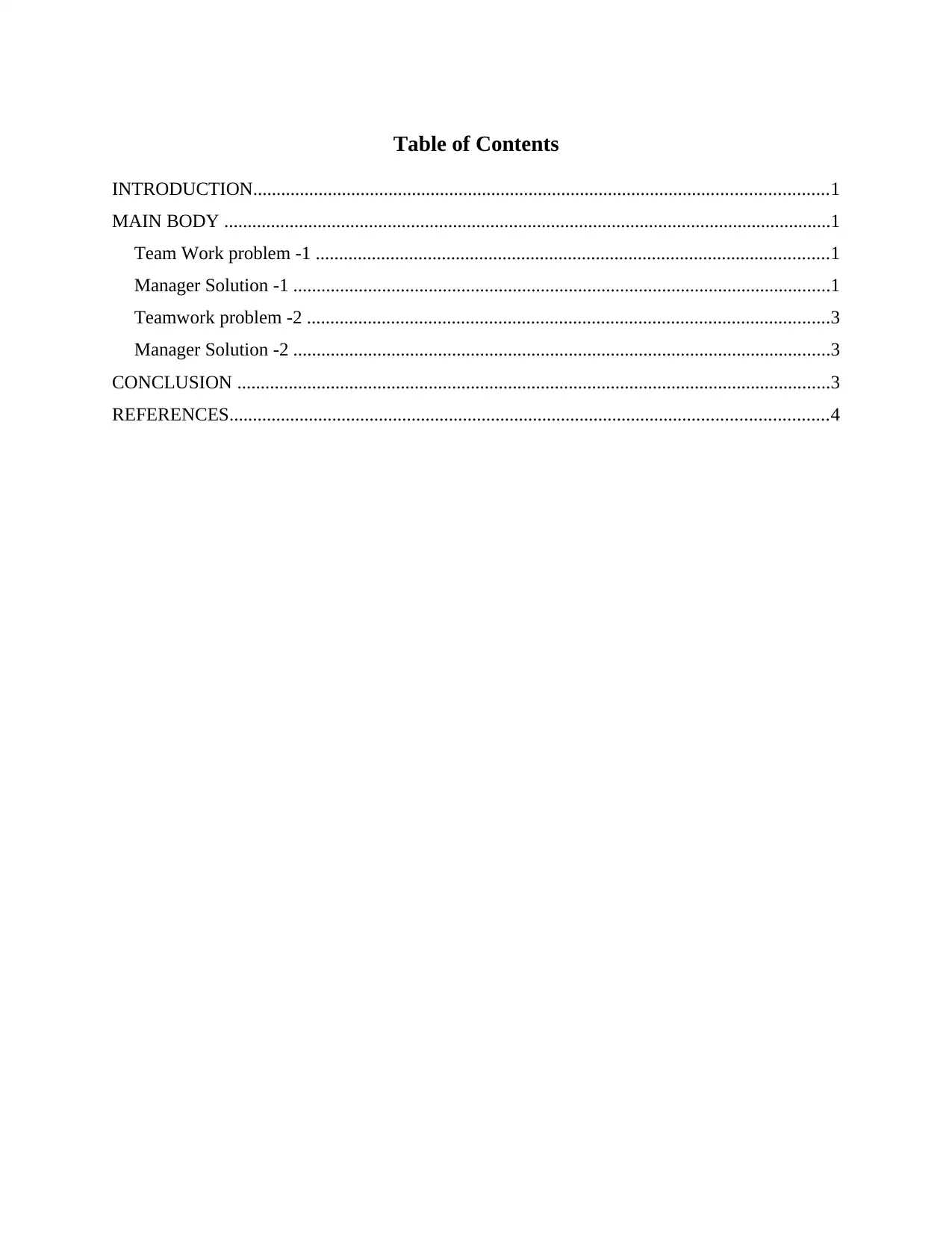
Table of Contents
INTRODUCTION...........................................................................................................................1
MAIN BODY ..................................................................................................................................1
Team Work problem -1 ..............................................................................................................1
Manager Solution -1 ...................................................................................................................1
Teamwork problem -2 ................................................................................................................3
Manager Solution -2 ...................................................................................................................3
CONCLUSION ...............................................................................................................................3
REFERENCES................................................................................................................................4
INTRODUCTION...........................................................................................................................1
MAIN BODY ..................................................................................................................................1
Team Work problem -1 ..............................................................................................................1
Manager Solution -1 ...................................................................................................................1
Teamwork problem -2 ................................................................................................................3
Manager Solution -2 ...................................................................................................................3
CONCLUSION ...............................................................................................................................3
REFERENCES................................................................................................................................4
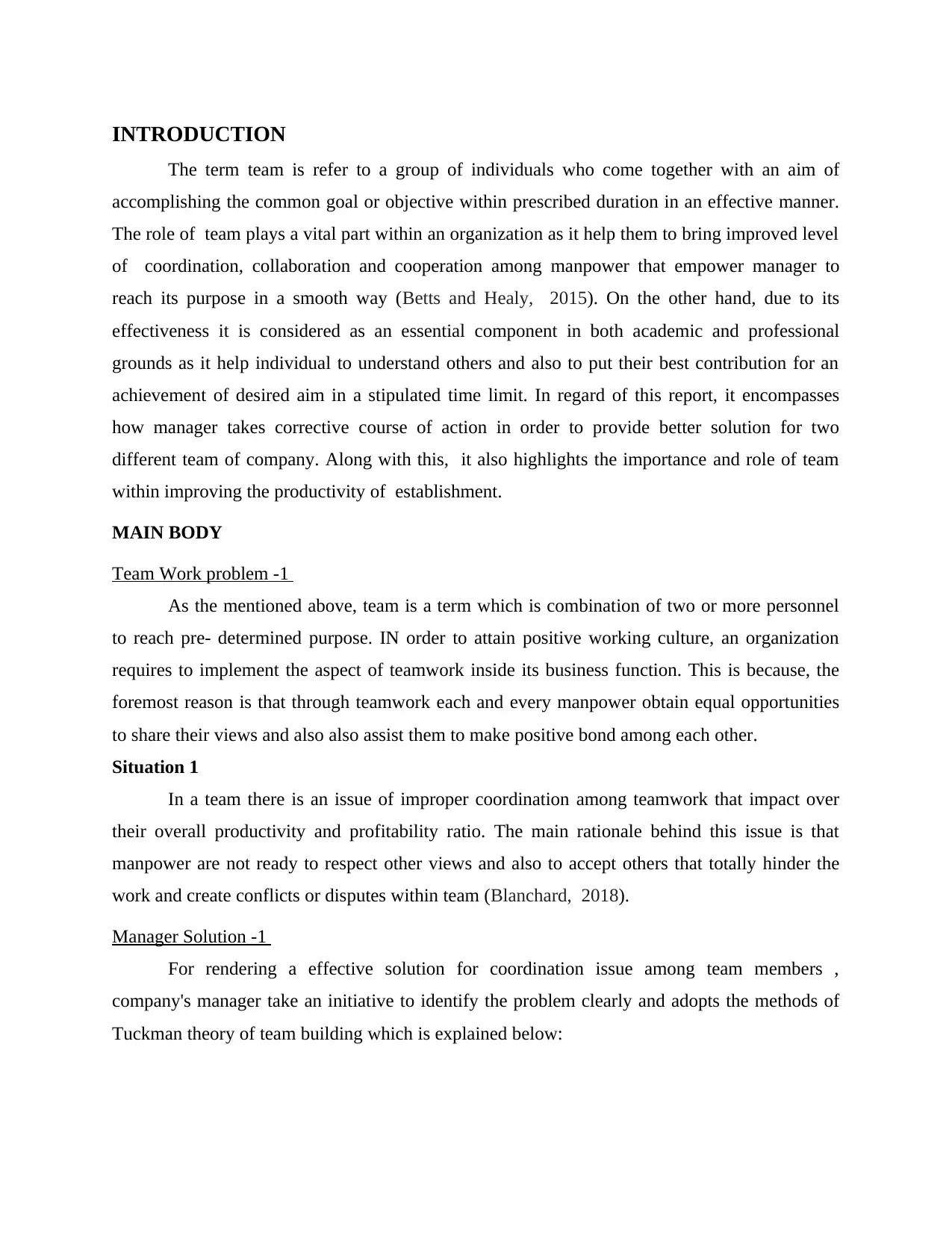
INTRODUCTION
The term team is refer to a group of individuals who come together with an aim of
accomplishing the common goal or objective within prescribed duration in an effective manner.
The role of team plays a vital part within an organization as it help them to bring improved level
of coordination, collaboration and cooperation among manpower that empower manager to
reach its purpose in a smooth way (Betts and Healy, 2015). On the other hand, due to its
effectiveness it is considered as an essential component in both academic and professional
grounds as it help individual to understand others and also to put their best contribution for an
achievement of desired aim in a stipulated time limit. In regard of this report, it encompasses
how manager takes corrective course of action in order to provide better solution for two
different team of company. Along with this, it also highlights the importance and role of team
within improving the productivity of establishment.
MAIN BODY
Team Work problem -1
As the mentioned above, team is a term which is combination of two or more personnel
to reach pre- determined purpose. IN order to attain positive working culture, an organization
requires to implement the aspect of teamwork inside its business function. This is because, the
foremost reason is that through teamwork each and every manpower obtain equal opportunities
to share their views and also also assist them to make positive bond among each other.
Situation 1
In a team there is an issue of improper coordination among teamwork that impact over
their overall productivity and profitability ratio. The main rationale behind this issue is that
manpower are not ready to respect other views and also to accept others that totally hinder the
work and create conflicts or disputes within team (Blanchard, 2018).
Manager Solution -1
For rendering a effective solution for coordination issue among team members ,
company's manager take an initiative to identify the problem clearly and adopts the methods of
Tuckman theory of team building which is explained below:
The term team is refer to a group of individuals who come together with an aim of
accomplishing the common goal or objective within prescribed duration in an effective manner.
The role of team plays a vital part within an organization as it help them to bring improved level
of coordination, collaboration and cooperation among manpower that empower manager to
reach its purpose in a smooth way (Betts and Healy, 2015). On the other hand, due to its
effectiveness it is considered as an essential component in both academic and professional
grounds as it help individual to understand others and also to put their best contribution for an
achievement of desired aim in a stipulated time limit. In regard of this report, it encompasses
how manager takes corrective course of action in order to provide better solution for two
different team of company. Along with this, it also highlights the importance and role of team
within improving the productivity of establishment.
MAIN BODY
Team Work problem -1
As the mentioned above, team is a term which is combination of two or more personnel
to reach pre- determined purpose. IN order to attain positive working culture, an organization
requires to implement the aspect of teamwork inside its business function. This is because, the
foremost reason is that through teamwork each and every manpower obtain equal opportunities
to share their views and also also assist them to make positive bond among each other.
Situation 1
In a team there is an issue of improper coordination among teamwork that impact over
their overall productivity and profitability ratio. The main rationale behind this issue is that
manpower are not ready to respect other views and also to accept others that totally hinder the
work and create conflicts or disputes within team (Blanchard, 2018).
Manager Solution -1
For rendering a effective solution for coordination issue among team members ,
company's manager take an initiative to identify the problem clearly and adopts the methods of
Tuckman theory of team building which is explained below:
⊘ This is a preview!⊘
Do you want full access?
Subscribe today to unlock all pages.

Trusted by 1+ million students worldwide
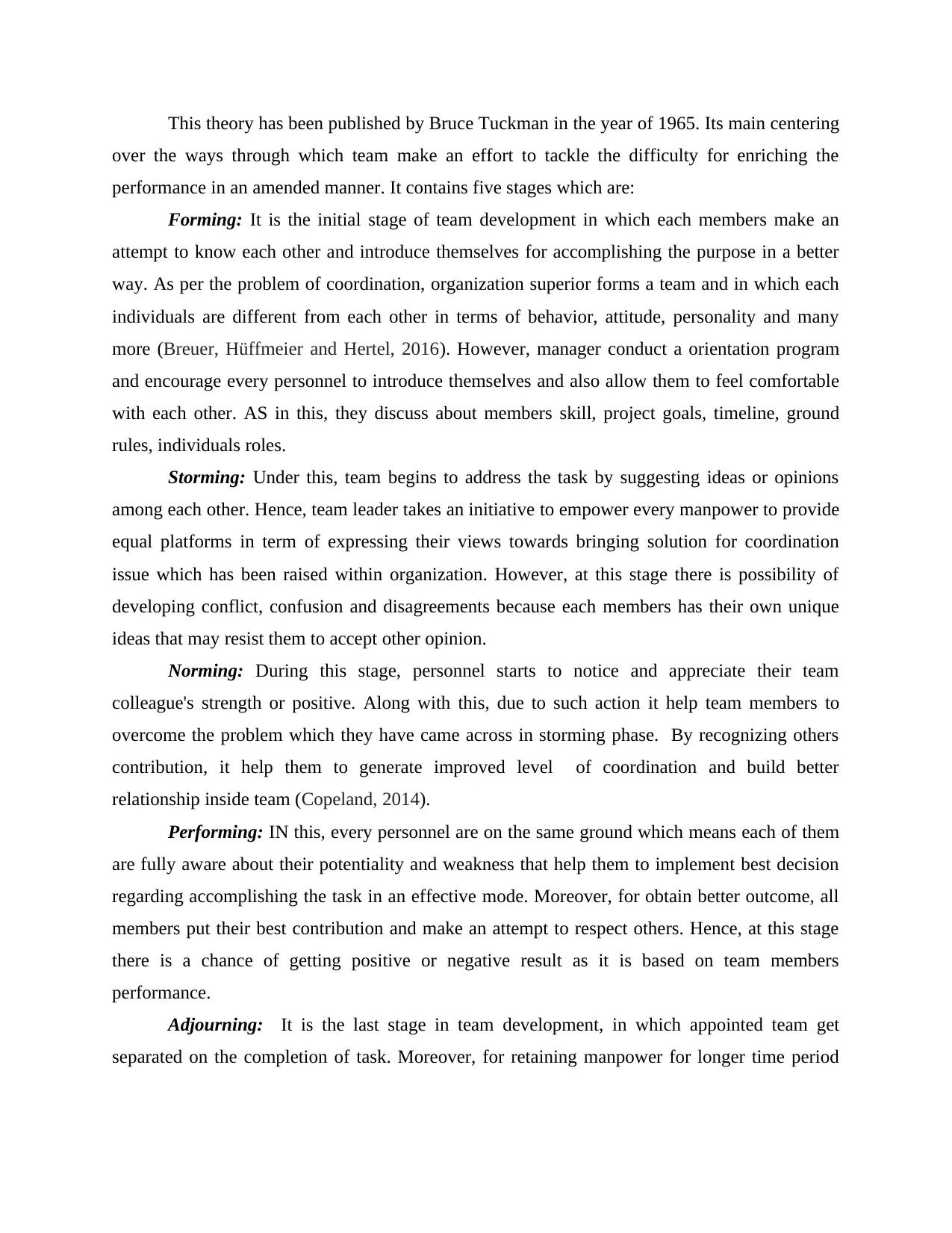
This theory has been published by Bruce Tuckman in the year of 1965. Its main centering
over the ways through which team make an effort to tackle the difficulty for enriching the
performance in an amended manner. It contains five stages which are:
Forming: It is the initial stage of team development in which each members make an
attempt to know each other and introduce themselves for accomplishing the purpose in a better
way. As per the problem of coordination, organization superior forms a team and in which each
individuals are different from each other in terms of behavior, attitude, personality and many
more (Breuer, Hüffmeier and Hertel, 2016). However, manager conduct a orientation program
and encourage every personnel to introduce themselves and also allow them to feel comfortable
with each other. AS in this, they discuss about members skill, project goals, timeline, ground
rules, individuals roles.
Storming: Under this, team begins to address the task by suggesting ideas or opinions
among each other. Hence, team leader takes an initiative to empower every manpower to provide
equal platforms in term of expressing their views towards bringing solution for coordination
issue which has been raised within organization. However, at this stage there is possibility of
developing conflict, confusion and disagreements because each members has their own unique
ideas that may resist them to accept other opinion.
Norming: During this stage, personnel starts to notice and appreciate their team
colleague's strength or positive. Along with this, due to such action it help team members to
overcome the problem which they have came across in storming phase. By recognizing others
contribution, it help them to generate improved level of coordination and build better
relationship inside team (Copeland, 2014).
Performing: IN this, every personnel are on the same ground which means each of them
are fully aware about their potentiality and weakness that help them to implement best decision
regarding accomplishing the task in an effective mode. Moreover, for obtain better outcome, all
members put their best contribution and make an attempt to respect others. Hence, at this stage
there is a chance of getting positive or negative result as it is based on team members
performance.
Adjourning: It is the last stage in team development, in which appointed team get
separated on the completion of task. Moreover, for retaining manpower for longer time period
over the ways through which team make an effort to tackle the difficulty for enriching the
performance in an amended manner. It contains five stages which are:
Forming: It is the initial stage of team development in which each members make an
attempt to know each other and introduce themselves for accomplishing the purpose in a better
way. As per the problem of coordination, organization superior forms a team and in which each
individuals are different from each other in terms of behavior, attitude, personality and many
more (Breuer, Hüffmeier and Hertel, 2016). However, manager conduct a orientation program
and encourage every personnel to introduce themselves and also allow them to feel comfortable
with each other. AS in this, they discuss about members skill, project goals, timeline, ground
rules, individuals roles.
Storming: Under this, team begins to address the task by suggesting ideas or opinions
among each other. Hence, team leader takes an initiative to empower every manpower to provide
equal platforms in term of expressing their views towards bringing solution for coordination
issue which has been raised within organization. However, at this stage there is possibility of
developing conflict, confusion and disagreements because each members has their own unique
ideas that may resist them to accept other opinion.
Norming: During this stage, personnel starts to notice and appreciate their team
colleague's strength or positive. Along with this, due to such action it help team members to
overcome the problem which they have came across in storming phase. By recognizing others
contribution, it help them to generate improved level of coordination and build better
relationship inside team (Copeland, 2014).
Performing: IN this, every personnel are on the same ground which means each of them
are fully aware about their potentiality and weakness that help them to implement best decision
regarding accomplishing the task in an effective mode. Moreover, for obtain better outcome, all
members put their best contribution and make an attempt to respect others. Hence, at this stage
there is a chance of getting positive or negative result as it is based on team members
performance.
Adjourning: It is the last stage in team development, in which appointed team get
separated on the completion of task. Moreover, for retaining manpower for longer time period
Paraphrase This Document
Need a fresh take? Get an instant paraphrase of this document with our AI Paraphraser
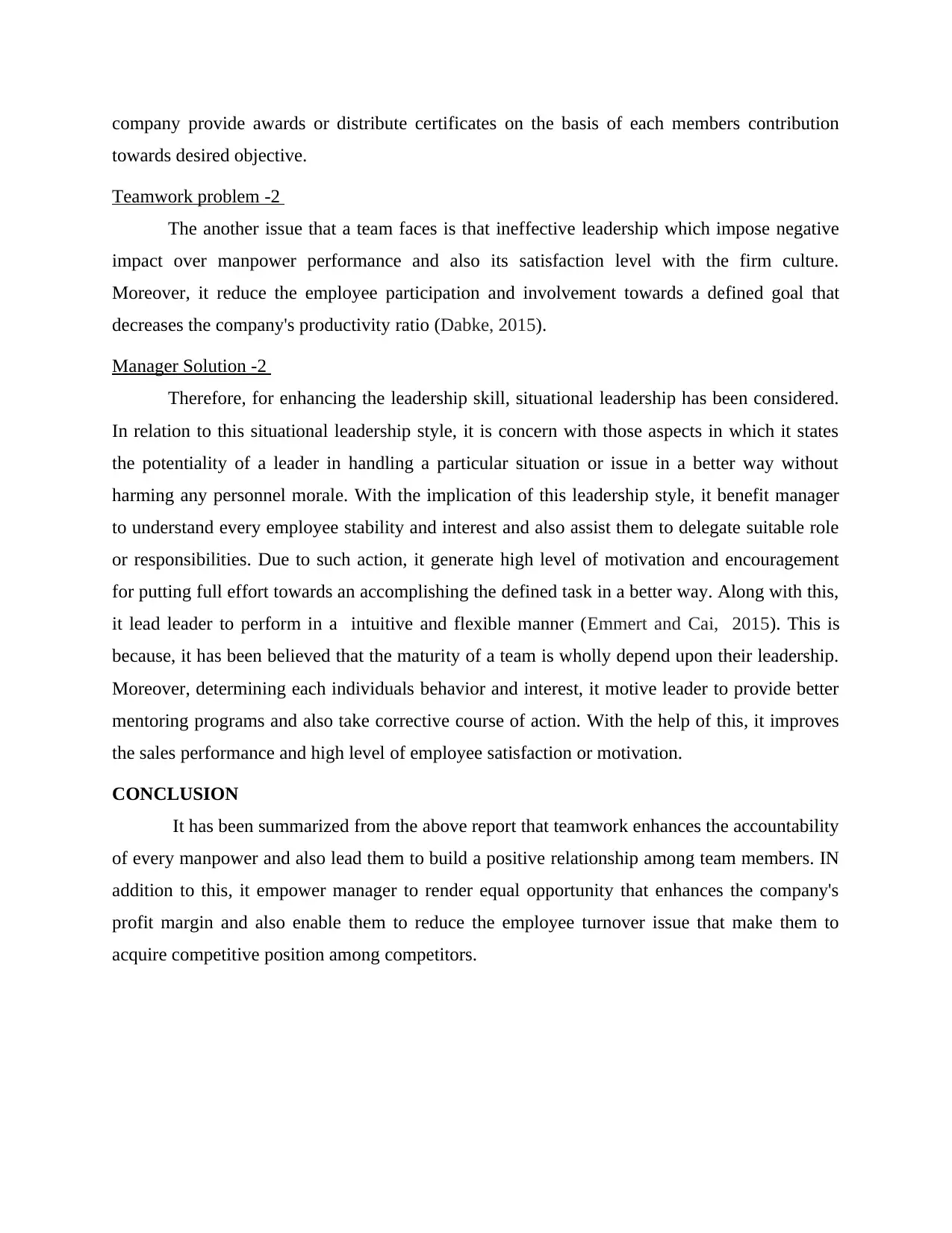
company provide awards or distribute certificates on the basis of each members contribution
towards desired objective.
Teamwork problem -2
The another issue that a team faces is that ineffective leadership which impose negative
impact over manpower performance and also its satisfaction level with the firm culture.
Moreover, it reduce the employee participation and involvement towards a defined goal that
decreases the company's productivity ratio (Dabke, 2015).
Manager Solution -2
Therefore, for enhancing the leadership skill, situational leadership has been considered.
In relation to this situational leadership style, it is concern with those aspects in which it states
the potentiality of a leader in handling a particular situation or issue in a better way without
harming any personnel morale. With the implication of this leadership style, it benefit manager
to understand every employee stability and interest and also assist them to delegate suitable role
or responsibilities. Due to such action, it generate high level of motivation and encouragement
for putting full effort towards an accomplishing the defined task in a better way. Along with this,
it lead leader to perform in a intuitive and flexible manner (Emmert and Cai, 2015). This is
because, it has been believed that the maturity of a team is wholly depend upon their leadership.
Moreover, determining each individuals behavior and interest, it motive leader to provide better
mentoring programs and also take corrective course of action. With the help of this, it improves
the sales performance and high level of employee satisfaction or motivation.
CONCLUSION
It has been summarized from the above report that teamwork enhances the accountability
of every manpower and also lead them to build a positive relationship among team members. IN
addition to this, it empower manager to render equal opportunity that enhances the company's
profit margin and also enable them to reduce the employee turnover issue that make them to
acquire competitive position among competitors.
towards desired objective.
Teamwork problem -2
The another issue that a team faces is that ineffective leadership which impose negative
impact over manpower performance and also its satisfaction level with the firm culture.
Moreover, it reduce the employee participation and involvement towards a defined goal that
decreases the company's productivity ratio (Dabke, 2015).
Manager Solution -2
Therefore, for enhancing the leadership skill, situational leadership has been considered.
In relation to this situational leadership style, it is concern with those aspects in which it states
the potentiality of a leader in handling a particular situation or issue in a better way without
harming any personnel morale. With the implication of this leadership style, it benefit manager
to understand every employee stability and interest and also assist them to delegate suitable role
or responsibilities. Due to such action, it generate high level of motivation and encouragement
for putting full effort towards an accomplishing the defined task in a better way. Along with this,
it lead leader to perform in a intuitive and flexible manner (Emmert and Cai, 2015). This is
because, it has been believed that the maturity of a team is wholly depend upon their leadership.
Moreover, determining each individuals behavior and interest, it motive leader to provide better
mentoring programs and also take corrective course of action. With the help of this, it improves
the sales performance and high level of employee satisfaction or motivation.
CONCLUSION
It has been summarized from the above report that teamwork enhances the accountability
of every manpower and also lead them to build a positive relationship among team members. IN
addition to this, it empower manager to render equal opportunity that enhances the company's
profit margin and also enable them to reduce the employee turnover issue that make them to
acquire competitive position among competitors.
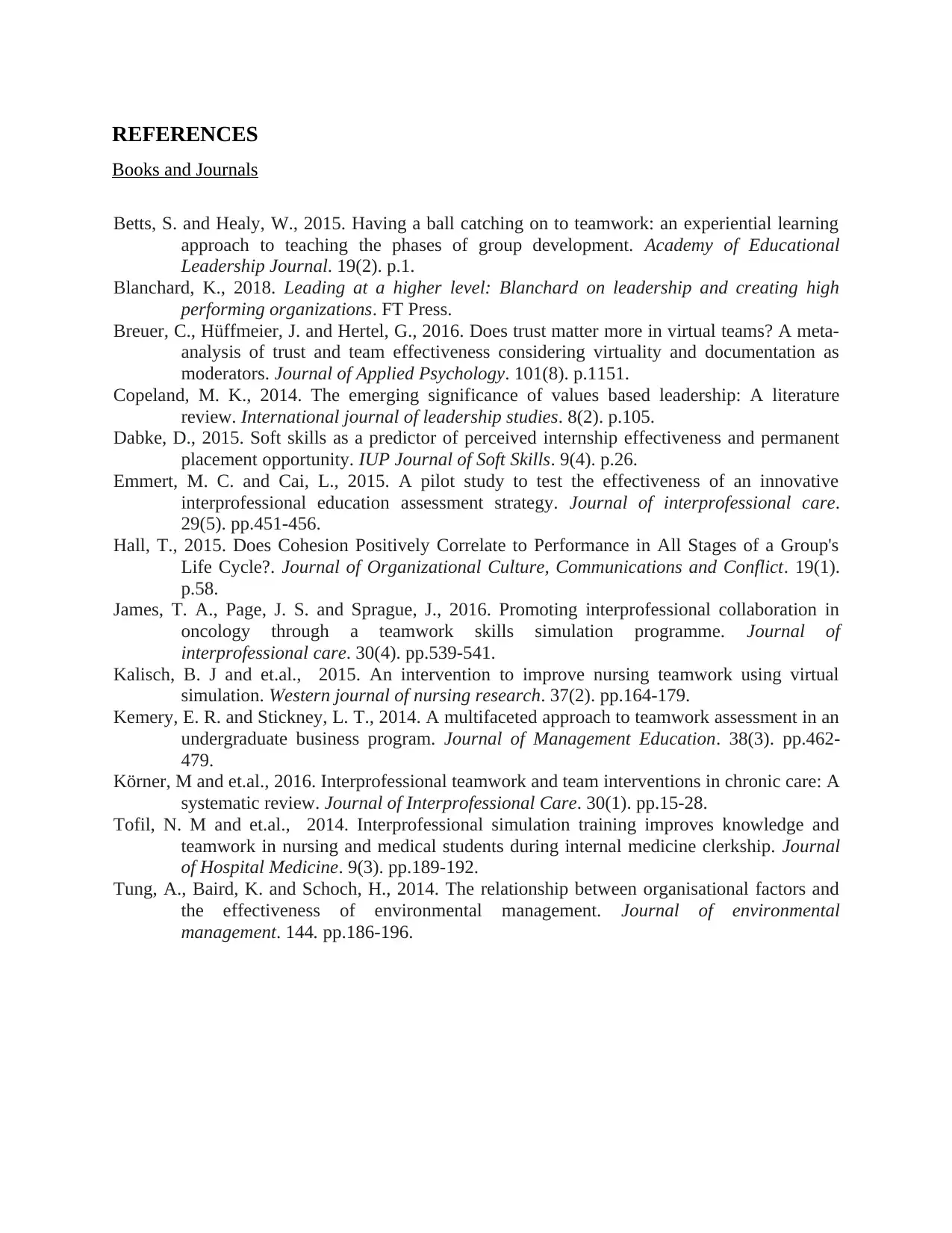
REFERENCES
Books and Journals
Betts, S. and Healy, W., 2015. Having a ball catching on to teamwork: an experiential learning
approach to teaching the phases of group development. Academy of Educational
Leadership Journal. 19(2). p.1.
Blanchard, K., 2018. Leading at a higher level: Blanchard on leadership and creating high
performing organizations. FT Press.
Breuer, C., Hüffmeier, J. and Hertel, G., 2016. Does trust matter more in virtual teams? A meta-
analysis of trust and team effectiveness considering virtuality and documentation as
moderators. Journal of Applied Psychology. 101(8). p.1151.
Copeland, M. K., 2014. The emerging significance of values based leadership: A literature
review. International journal of leadership studies. 8(2). p.105.
Dabke, D., 2015. Soft skills as a predictor of perceived internship effectiveness and permanent
placement opportunity. IUP Journal of Soft Skills. 9(4). p.26.
Emmert, M. C. and Cai, L., 2015. A pilot study to test the effectiveness of an innovative
interprofessional education assessment strategy. Journal of interprofessional care.
29(5). pp.451-456.
Hall, T., 2015. Does Cohesion Positively Correlate to Performance in All Stages of a Group's
Life Cycle?. Journal of Organizational Culture, Communications and Conflict. 19(1).
p.58.
James, T. A., Page, J. S. and Sprague, J., 2016. Promoting interprofessional collaboration in
oncology through a teamwork skills simulation programme. Journal of
interprofessional care. 30(4). pp.539-541.
Kalisch, B. J and et.al., 2015. An intervention to improve nursing teamwork using virtual
simulation. Western journal of nursing research. 37(2). pp.164-179.
Kemery, E. R. and Stickney, L. T., 2014. A multifaceted approach to teamwork assessment in an
undergraduate business program. Journal of Management Education. 38(3). pp.462-
479.
Körner, M and et.al., 2016. Interprofessional teamwork and team interventions in chronic care: A
systematic review. Journal of Interprofessional Care. 30(1). pp.15-28.
Tofil, N. M and et.al., 2014. Interprofessional simulation training improves knowledge and
teamwork in nursing and medical students during internal medicine clerkship. Journal
of Hospital Medicine. 9(3). pp.189-192.
Tung, A., Baird, K. and Schoch, H., 2014. The relationship between organisational factors and
the effectiveness of environmental management. Journal of environmental
management. 144. pp.186-196.
Books and Journals
Betts, S. and Healy, W., 2015. Having a ball catching on to teamwork: an experiential learning
approach to teaching the phases of group development. Academy of Educational
Leadership Journal. 19(2). p.1.
Blanchard, K., 2018. Leading at a higher level: Blanchard on leadership and creating high
performing organizations. FT Press.
Breuer, C., Hüffmeier, J. and Hertel, G., 2016. Does trust matter more in virtual teams? A meta-
analysis of trust and team effectiveness considering virtuality and documentation as
moderators. Journal of Applied Psychology. 101(8). p.1151.
Copeland, M. K., 2014. The emerging significance of values based leadership: A literature
review. International journal of leadership studies. 8(2). p.105.
Dabke, D., 2015. Soft skills as a predictor of perceived internship effectiveness and permanent
placement opportunity. IUP Journal of Soft Skills. 9(4). p.26.
Emmert, M. C. and Cai, L., 2015. A pilot study to test the effectiveness of an innovative
interprofessional education assessment strategy. Journal of interprofessional care.
29(5). pp.451-456.
Hall, T., 2015. Does Cohesion Positively Correlate to Performance in All Stages of a Group's
Life Cycle?. Journal of Organizational Culture, Communications and Conflict. 19(1).
p.58.
James, T. A., Page, J. S. and Sprague, J., 2016. Promoting interprofessional collaboration in
oncology through a teamwork skills simulation programme. Journal of
interprofessional care. 30(4). pp.539-541.
Kalisch, B. J and et.al., 2015. An intervention to improve nursing teamwork using virtual
simulation. Western journal of nursing research. 37(2). pp.164-179.
Kemery, E. R. and Stickney, L. T., 2014. A multifaceted approach to teamwork assessment in an
undergraduate business program. Journal of Management Education. 38(3). pp.462-
479.
Körner, M and et.al., 2016. Interprofessional teamwork and team interventions in chronic care: A
systematic review. Journal of Interprofessional Care. 30(1). pp.15-28.
Tofil, N. M and et.al., 2014. Interprofessional simulation training improves knowledge and
teamwork in nursing and medical students during internal medicine clerkship. Journal
of Hospital Medicine. 9(3). pp.189-192.
Tung, A., Baird, K. and Schoch, H., 2014. The relationship between organisational factors and
the effectiveness of environmental management. Journal of environmental
management. 144. pp.186-196.
⊘ This is a preview!⊘
Do you want full access?
Subscribe today to unlock all pages.

Trusted by 1+ million students worldwide
1 out of 6
Related Documents
Your All-in-One AI-Powered Toolkit for Academic Success.
+13062052269
info@desklib.com
Available 24*7 on WhatsApp / Email
![[object Object]](/_next/static/media/star-bottom.7253800d.svg)
Unlock your academic potential
Copyright © 2020–2025 A2Z Services. All Rights Reserved. Developed and managed by ZUCOL.




